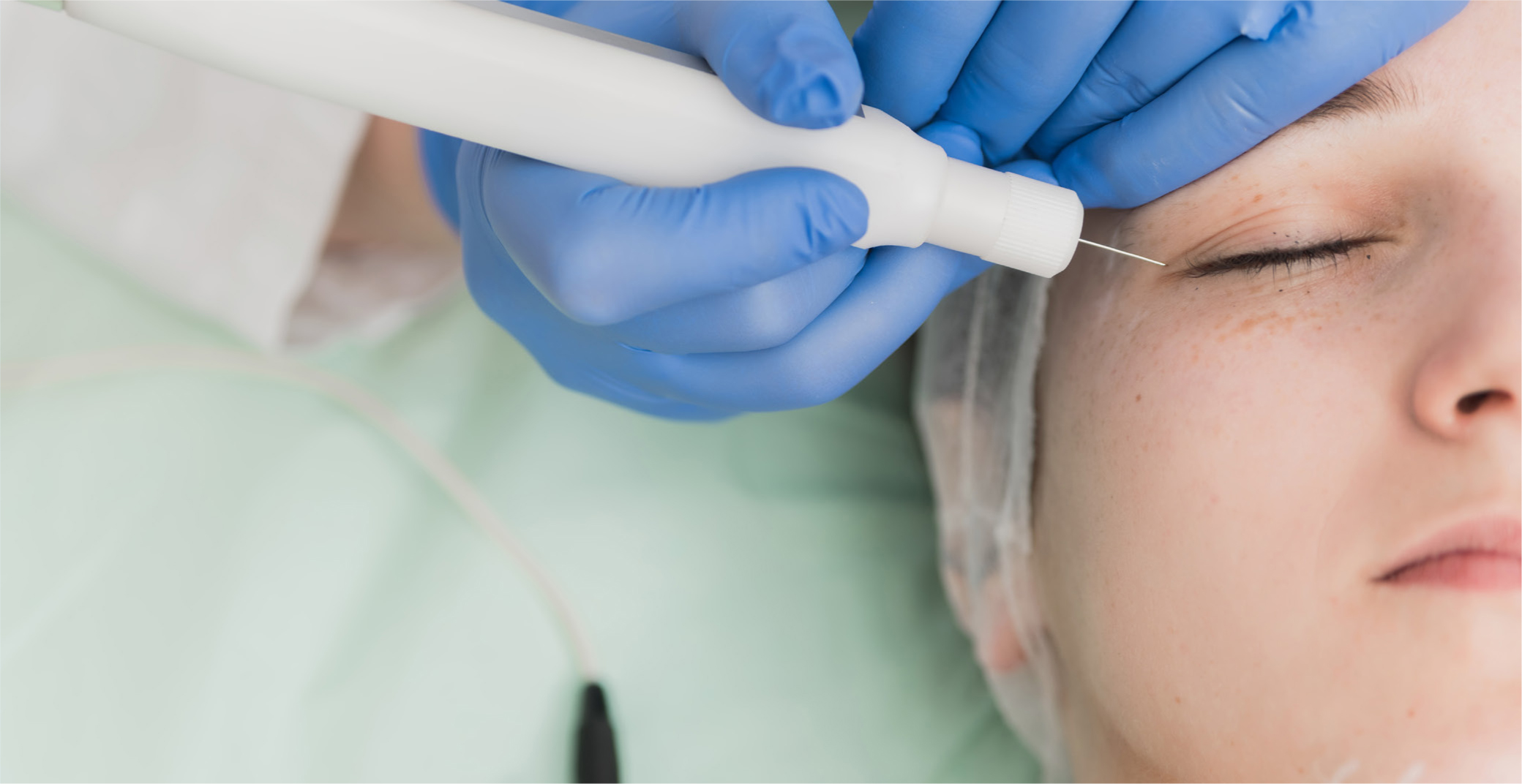
Plasma electrosurgical devices have long been employed for tissue coagulation, cutting and cauterising. In the past few years, according to Gay-Mimbera et al, plasma medicine has been full of innovations. This field of aesthetics looks to ‘control the interactions between plasma components (as well as other secondary species that can be formed from these components) with specific structural elements and functionalities of living cells’ (2017).
Back to basics
Plasma is a resurfacing method that ‘uses plasma energy to create a thermal effect on the skin’ (Foster et al, 2008). This method differs from lasers, as it does not depend on chromophores or vapourise tissue. Instead, it leaves an intact layer of desiccated epidermis, which ‘acts as a natural biologic dressing and promotes wound healing and rapid recovery’ (Foster et al, 2008).
Plasma is often referred to as the fourth state of matter, which comprises of ionised atoms (Sotiris et al, 2014). It is created when electrostatic energy mixes with an ionised gas. When the thermal energy from a plasma device reaches around 1-mm from the skin, it mixes with oxygen and nitrogen in the atmosphere and creates a plasma arc, which vaporises upon contact with the skin. (Sotiris et al, 2014)
According to Fridman, ‘plasma can exist in a variety of forms and can be created in different ways’ (2011). Plasma action's mechanism on the skin involves two steps: immediate tissue contraction and thermal disruption. After the thermal effect of plasma, the denaturation of collagen and other proteins in the dermis induces clinically observed, immediate tissue contraction. Cold, as well as thermal, plasma is already used for a range of therapeutic applications, and the application of plasma has enormous potential. For example, plasma can also be used in wound healing for sterilising or disinfecting (Heinlin et al, 2010).
Periocular dermatochalasis and non-surgical blepharoplasty
Periocular dermatochalasis (also known as excessively loose eyelid skin) is mostly found in the upper eyelids where skin loses elasticity, thus dropping both outwards and down onto the eyelashes, resulting in droopy eyelids and even supero-lateral visual field obstruction. The periocular region is the first to display signs of early ageing which, naturally, brings with it several patient concerns, including dark circles, eyelid skin folding and lower lid bags. However, if this is not caused by involutional changes that accompany ageing, periocular dermatochalasis can also be a result of repeat swelling.
Increasingly, it is being found that non-surgical blepharoplasty using plasma is becoming a more attractive alternative to surgery, as it eliminates the need for general anaesthetic which, in turn, means there is no risk of allergic reaction, blood clot or pulmonary/cardiac complications. Further benefits of non-surgical blepharoplasty include a faster healing process and reduced chance of any scarring or damage to the patient's vision or muscles (King, 2017).
Preparing and assessing the upper eyelid
Often, practitioners find it useful to refer to pictures of the patient at a younger age, as this can aid in the restoration of youthfulness and a natural look, while it is necessary to assess preseptal fat pads when redefining the superior sulcus (Naik et al, 2009).

While plasma is a suitable treatment for patients with excessive eyelid skin, those with extreme hooding or pronounced subcutaneous fat in the upper lid may opt for a surgical procedure for various reasons, including personal preference. Following assessment, the patient is prepared using skin disinfectant and the application of a topical anaesthetic.
Post-treatment considerations
As a result of carbonising tissue, the patient will have small brown spots on the areas that have been treated with plasma. These will last around five to seven days. While they will fall off naturally, the patient should not pick them, as this increases the chance of scarring. The day after the treatment, there ‘may be considerable peri-orbital swelling which resolves over the next 24–48 hours, this may be even longer if both the upper and lower lids are treated at the same time’ (King, 2017).
While the non-surgical procedure eliminates the chances of other common complications which accompany blepharoplasty, it has its own set of possible complications, including infection, bruising, asymmetry and pigmentation. Plasma technology has proven to be safe, with data suggesting that there is no scarring because the basement membrane is not breached. However, as can be expected from any procedure that causes damage to the epidermis, scarring can occur from improper use, so adequate education and training is necessary (King, 2017).
Health Canada has listed the following side effects of this procedure to include ‘pain, swelling of the treated area, redness, sagging skin (particularly in the upper eyelids), hyperpigmentation (spots), ultraviolet (UV) sensitivity and skin peeling and crusting’ (Taylor, 2018). These side effects can happen even when the device is used properly. If used improperly, other risks include:
However, it is interesting to note that Canada does not permit the use of such devices to be used, with Health Canada stating that, ‘Plasma pens have not been approved for sale in Canada, which means that they have not been evaluated for safety … It is recommended that consumers avoid the use of plasma pens/fibroblast devices that may be offered at spas, cosmetic clinics, or any other location including private homes’ (Windsor-Essex County Health Unit, 2019).
Companies selling unauthorised plasma pens have been contacted by Health Canada, informing them that it is ‘illegal to advertise, import for sale, or sell these devices without the proper approvals and licensing’ (Windsor-Essex County Health Unit, 2019). Aestheticians and spas have also been made aware of licensing requirements, as well as possible risks and complications (Taylor, 2018).
Plasma contraindications
Certain patients are not suitable for plasma treatments. This includes patients ‘with an ongoing anticoagulant treatment, wearing pacemakers or metallic objects in the treatment area such as piercings, suffering from epilepsy, pregnant or breastfeeding women, or with an infectious skin disease on the treatment zones, or patients who were exposed to tanning beds, natural sunlight or who had high skin phototypes’ (de Goursac, 2018).
Surgical smoke plume
It must be noted that there is a worry about the surgical smoke plume from these devices that could have an impact on the practitioner. Little is known or discussed about this, but the evidence below speaks volumes.
Surgical smoke plume is defined as ‘a potentially dangerous byproduct generated from the use of energy-based devices such as laser and electrosurgical units’ (Schuco, 2019). Such devices cause tissue to vapourise and expel into the air, to be then inhaled by the practitioner and patient.
During such procedures, smoke plumes cause bacteria and viruses, as well as other chemicals and toxins, to be released into the air. The smallest particles released are usually viruses which travel deepest into the human body. Surgical smoke evacuators are necessary because, if not used, the practitioner and patient both inhale these particles, thus carrying bacterial and viral pathogens directly into the respiratory system. Toxins commonly found in smoke plume are carbon monoxide, methane, benzene, formaldehyde, hydrogen cyanide and phenol (Schuco, 2019).
One risk of inhaling smoke plumes is human papillomavirus (HPV). There are numerous case studies which examine perioperative professionals who work with lasers and electrosurgical devices who have HPV-positive cancerous masses (Stratton, 2017).
In conclusion, the use of plasma in aesthetics is a suitable non-surgical approach to combatting ageing and periocular dermatochalasis, but requires expert training and knowledge to ensure it is safe for both the patient and practitioner. Certain precautions should be made to carry out procedures safely, like the implementation of smoke evacuation units, which are essential as they remove the smoke plumes and cellular matter from the air.


